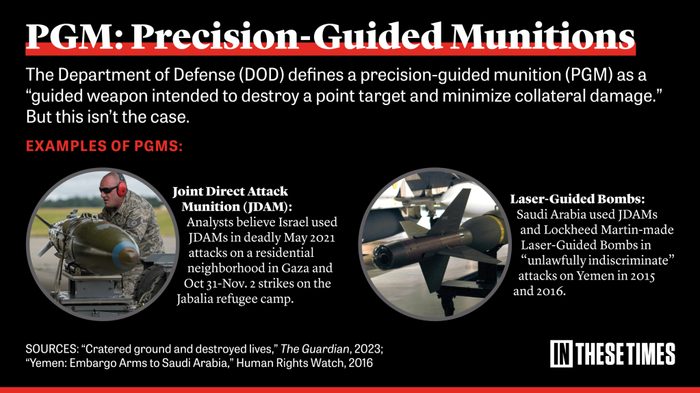How Israel Got an Enless Supply of U.S.-Made Smart Bombs

The United States has had the authority to quietly transfer precision-guided munitions, or PGMs, to Israel for the past three years through a little-noticed provision passed by Congress in January 2021.
Section 1275 of the 2021 National Defense Authorization Act (NDAA) allows a limitless transfer of PGMs from U.S. reserve stocks to Israel’s stockpile without normal congressional notifications, as long as U.S “combat readiness” isn’t compromised.
PGMs — which include any guided missile designed to hit an extremely precise target — have been an Israeli weapon of choice in the massive and deadly bombardment that has destroyed an estimated 98,000 buildings in Gaza and reportedly killed more than 15,000 Palestinians. Satellite-guided bombs (a type of PGM) of between 1,000 and 2,000 pounds made up about 90% of the weapons the Israeli military used in the first two weeks after October 7.

While PGM’s advanced targeting is billed as a way to avoid civilian harm, they have been linked to many strikes by Israel and other U.S. allies on densely populated areas, including homes in central Gaza and the Jabalia refugee camp. A spokesperson for the Israel Defense Forces (IDF) admitted to CNN’s Wolf Blitzer that they struck the camp knowing the area was crowded with civilians.
President Joe Biden says that the United States has been “surging additional military assistance” to Israel since October 7. But government reporting on the details of that assistance has been sporadic and opaque.
Now, a source in the State Department confirms to In These Times and Women for Weapons Trade Transparency that Section 1275 has been invoked since October 7 to rush more PGMs to Israel.

Analysts believe Israel used Boeing-manufactured JDAMs, a type of precision-guided missile, in strikes on the Jabalia refugee camp in Gaza that left an estimated 195 dead.PHOTO BY SAMI ABU TABAK/ANADOLU VIA GETTY IMAGES
An endless stockpile
Israel lobbied the United States for greater access to PGMs in the wake of its 2014 assault on Gaza that left some 2,200 Palestinians dead. The Israeli government argued that it needed more smart bombs to use against Hamas and Hezbollah in case of emergency. Section 1275 of the 2021 NDAA was seemingly meant to fulfill that request, enabling the president to bypass normal weapons spending caps on transfers of PGMs already stored in U.S. reserves.
“Although it is almost impossible for independent experts to trace due to a lack of basic transparency, there is little doubt that Israel and the U.S. took advantage of the provision,” says William Hartung, senior research fellow at the Quincy Institute for Responsible Statecraft. “The whole purpose of doing it in this fashion is to hide the extent of these deadly transfers — and the mechanisms used to carry them out — from public view.”
The Jerusalem Post reported in 2021 that the United States quickly replenished the hundreds of PGMs dropped on the Gaza Strip in May 2021 and that Israel planned to purchase “far more” by 2024.
Hartung says that the common-sense logic in Washington D.C. is that U.S. weapons transfers should “increase stability” or “bolster the ability of allies to defend themselves.”
“While this may be true in some cases, in many others — such as U.S. arms supplies to Saudi Arabia for use in the war in Yemen or for Israel’s war on Gaza — pouring in arms to regions of tension enables human rights abuses, entrenches authoritarian regimes and fuels deadly conflict,” he says.
A New York Times investigation found that Israel used JDAMs — a type of PGM — in May 2021 attacks on a Gaza apartment complex that killed civilian families.
Civilian killings, precisely targeted
The Biden administration argues that guided weapons are a valuable tool to reduce civilian casualties by enabling more precise targeting. But U.S. policy decisions have tacitly admitted that sometimes the opposite is true. In 2016, President Barack Obama’s administration suspended PGM sales to Saudi Arabia due to “systemic, endemic” concerns that the advanced weaponry was deployed against civilian targets.
Supplying these attack munitions to Israel, a government with a history of striking civilian infrastructure with PGMs — and which has publicly stated that the emphasis of its bombing of Gaza is “damage and not accuracy” — has been particularly controversial.
When the State Department notified Congress on October 31 that it planned to transfer $320 million in kits to convert unguided bombs into precision munitions, Rep. Ilhan Omar (D-Minn.) introduced a resolution of disapproval in a move applauded by peace and arms control civil society groups, including Women for Weapons Trade Transparency.
There is ample evidence that PGMs have been used in the current Israeli campaign in strikes against civilian infrastructure. Marc Garlasco, a military advisor at the Dutch peace organization PAX, says that “photos of weapon remnants, craters, and reporting out of Israel and Gaza indicate strikes carried out in Gaza City, including strikes at multiple refugee camps, were conducted with GBU-31’s and other .” Analysts believe Israel used a Boeing-manufactured guided bomb unit, a kind of PGM, during its Oct. 31-Nov. 2 airstrikes on Jabalia Refugee Camp, which reportedly killed 195 people.
An Amnesty International investigation released December 5 traced the killing of 43 civilians in Gaza — including 19 children — back to Boeing-made JDAMs (a type of PGM) supplied by the United States. After ordering residents of Northern Gaza to relocate south, the Israeli military struck family homes in Deir al-Balah, below the evacuation line, without warning. The strikes killed 24 people on October 10 and 19 people on October 22. (This story has been updated to include the Amnesty report.)
Less and less transparency
In its request for $14.5 billion in military aid to Israel, the Biden administration is following the precedent set by Section 1275 and other NDAA amendments by further undercutting transparency in all stockpile transfers, not just for PGMs. The President’s requested supplemental bill would waive the annual cap on transfers to the U.S. stockpile within Israel. With no limit on those transfers and Israel’s ability to draw from that stockpile at will, the U.S. would supply Israel with a virtually endless supply of weaponry without congressional authorization or oversight.
The Senate is currently working to pass the supplemental, with Senate Majority Leader Chuck Schumer (D-N.Y.) saying the bill could be up for a vote as early as this week.
The White House’s supplemental request also contained another transparency waiver, first reported by Women for Weapons Trade Transparency and In These Times last month, which would let the White House unilaterally blanket-approve future sales of military equipment and weapons to Israel without notifying Congress.
In response, some Democrats want stronger assurances that U.S. weapons will be used consistently with U.S. law and called for greater transparency in transfers.
Several high-ranking Democrats have already come out against giving Biden increased powers to transfer weapons to Israel without scrutiny. “We should not make exceptions to this practice — it’s our duty to review these funds and ensure their use is in the best interests of the American people and in alignment with U.S. policy,” Sen. Chris Van Hollen (D-Md.), a member of the Foreign Relations Committee, said in a statement to the Washington Post.
Sen. Schumer’s office did not respond by deadline to an inquiry about whether the two transparency waivers will be included in the bill.
